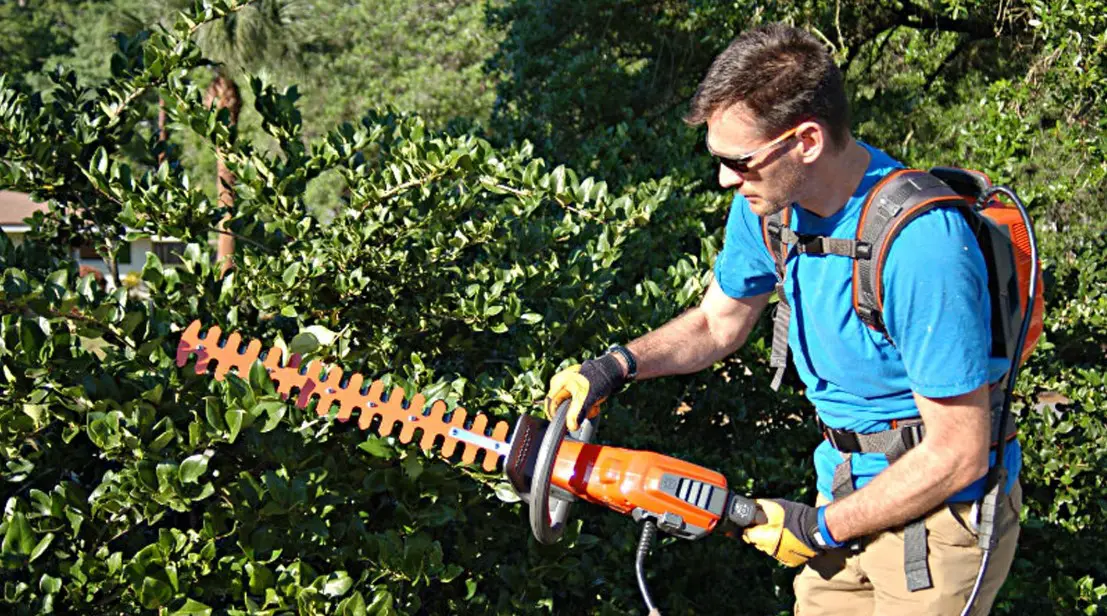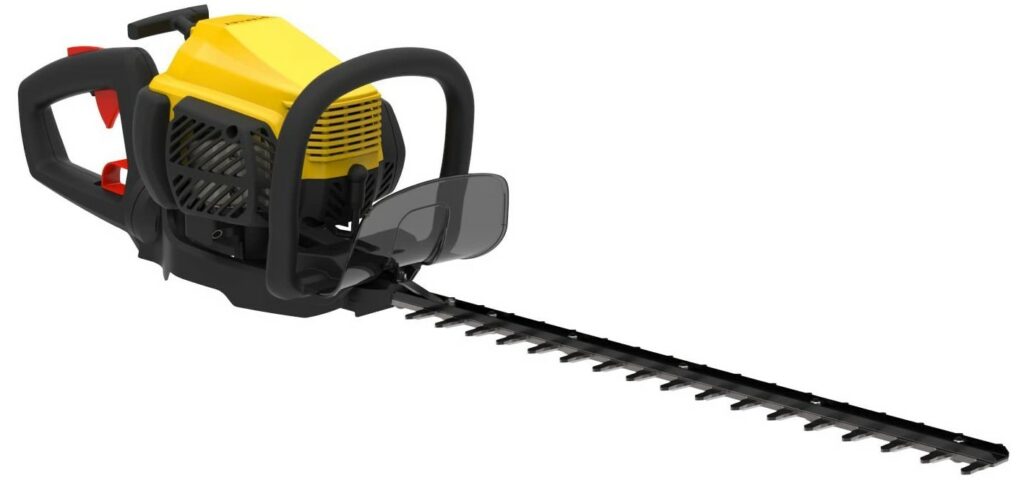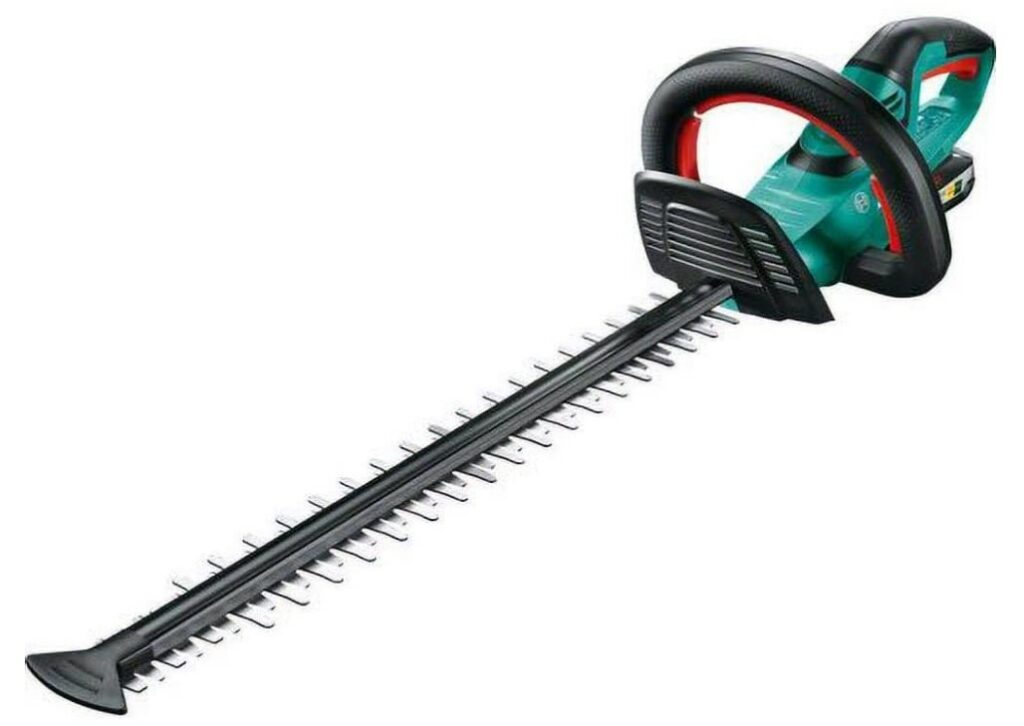At its most basic level, a hedge trimmer is a machine specially designed to trim hedges. But then, you could use hand shears, scissors, a machete or even a lawn mower to do the job (please don’t try these last two!) but none of them really qualify as hedge trimmers.
Defining The ‘Hedge Trimmer’
First off, there are hedge trimmers and hedge cutters. I know, not very helpful, is it?
I’ll talk more about this later, but let’s begin by finding out what a hedge trimmer is.
In essence, it’s a machine with a motor or an engine that powers a set of blades that can be used to cut excess growth from bushes, shrubs and hedges. The key is in the word trim: these aren’t designed for heavy-duty work. You won’t be able to hack through the trunk of that annoying 30ft Leylandii with it!
Scissor Action
Most models have two blades that move in opposition to each other (reciprocating blades) to create a scissor action that slices through the bush efficiently.
However, there are dozens of different models and types, mostly categorised by their power source, and it can be difficult to know which one is best.
In my search for the perfect hedge trimmer, I looked at hundreds of machines and learned a lot about them, so I’m passing this knowledge on to help you gain a better idea of what’s what.
Armed with this new understanding, you’ll hopefully be better equipped to find the right one for your needs.
Electric Hedge Trimmers
We’ll begin with the corded electric hedge trimmer as it’s a popular choice. Not everyone has acres of garden to tame, so a basic model that you can simply plug in and tidy the hedges is always going to be a winner.
The main concern with electric hedge trimmers is the possibility of cutting through the cable, and you be surprised (or maybe not!) at the number of times this happens. The good news is that corded trimmers are us usually double insulated (check the casing for the symbol of a square inside a square) so there’s very little risk of an electric shock.
This means that none of the metal parts or live wires inside the trimmer can touch the outer casing and allow an electric current to pass through into the user.
Stay Safe! Don’t Mess With Electrics
Aside from being a potential health hazard, slicing through the power cord could mean the end of your hedge trimmer, unless you can get it fixed. Never try to do this yourself unless you are 100% confident if getting it right. Mixing up the wiring can result in a fatal accident.
However, with a bit of common sense and by remaining alert and vigilant while you work, you should be able to avoid cutting the cord anyway.
Cordless Electric Hedge Trimmers
To get around the issue of accidental cord-cutting entirely, how about a cordless electric hedge trimmer?
These have evolved in the last few years to become reliable, powerful machines, with an obvious advantage over the corded hedge trimmer; they are more portable, allowing greater range without the need for an extension cord. You also have more freedom of movement, too, as you aren’t restricted by the cable.
Of course, you’ll need to remember to charge the battery. And you’ll need to keep in mind that some outlets sell battery-powered models without a battery or charger. These are sold separately, so be sure to check what you’re getting before you buy online!
Hedge Trimmer Or Hedge Cutter?
This can get really confusing, as most shops use both terms to describe the same tools to maximise online traffic!
I dived into the differewnce between a hedge cutter and a hedge trimmer previously.
However, I’ll try to explain it as simply as possible:
Hedge Trimmers
As I pointed out earlier, these are for lighter work, tidying and shaping hedges, bushes and small shrubs. The teeth are usually placed closer together as you won’t be tackling anything too thick. As a rule, they are designed to cut branches ¾ inch thick. If you frequently chop through anything thicker, you’re likely to bend or break the teeth and burn out the motor.
Hedge Cutters
A hedge cutter tends to be more powerful, built to cope with heavy-duty work for long periods. They’re often petrol models with plenty of punch, and the teeth are spaced further apart so they can crunch through larger branches.
Even so, they are not designed to take the place of a saw! Always check the specifications to discover the maximum thickness that the unit can cut through, and never try to exceed this or you risk damaging the tool.
Maintenance: Boring But Necessary!
Whichever type of hedge trimmer you choose, you’ll need to commit to regular maintenance to keep it in good working order.
At the very least, you’ll need to give it a good wipe-down with a damp cloth after each trimming session. Check that nothing is caught between the blades and remove any debris, then dry it off with a cloth or paper towel.
Use The Right Oil
Keep the unit well lubricated with an appropriate oil (as recommended in the manual*) so that the parts can move freely and don’t rust or seize up. After it’s all clean and you’ve applied the oil, switch it on and let it run for a minute or so to distribute the lubrication evenly.
*Men should take particular note of this, as they are statistically less likely to read the manual! This is important, as it provides safety advice as well as maintenance tips.
Keep the blades sharp
You’ll also need to sharpen your hedge trimmer blades once in a while (it all depends on how often you use the trimmer and for how long) to ensure efficient cutting each time. You can easily do this at home yourself. I find that a flat-file and whetstone does the job perfectly.
Alternatively, there are plenty of garden centres or garden equipment stores that offer a sharpening service.
Petrol Power = More Maintainance
On the whole, petrol-driven (or gas-powered, as our American friends say) hedge trimmers require more maintenance as they are more complex. You’ll need to check the spark plug, carburettor, air filter etc. They are also more prone to loose screws and bolts because they vibrate a fair bit, so you’ll need to tighten anything that has shaken loose.
Storing a petrol hedge trimmer for many months can cause gunk to build-up in the carburettor, so that’s something you need to keep an eye on.
Proper Storage
Finally, you’ll need to store your hedge trimmer in a dry, safe place to prevent damage or rust. If you can, keep it covered to prevent dust or condensation from getting into it, and cover the blade teeth to avoid them being bent, or to stop any accidents: these are sharp even when not in action!
Double-Sided Hedge Trimmers?
You might find hedge trimmers advertised as double or single-sided. However, there’s no need to get too hung up on this! The vast majority of hedge trimmers are double-sided, meaning that they have teeth on both sides of the blade.
For those wanting to know about what a double sided hedge trimmer is I covered this previously.
These are more versatile and allow you to shape the hedge or bush easily as you can move the trimmer both ways.
Single-sided units have teeth only on one side, and these are more likely to be used for large-scale projects by horticultural professionals and contractors.
Having tested out both, it’s clear (to me, at least!) that the two-way cutting system is better for the average garden enthusiast.
What About Cutting Action?
Another term to watch out for is the cutting action of your chosen hedge trimmer.
Confusingly, the different types are also referred to as single or double, but have nothing to do with previous point!
Let’s make it a bit clearer:
Single Action
These have one moving blade and one fixed blade. Because one blade is stationary and fixed to the main body of the unit, there tends to be more vibration. And these models don’t always give the best finish to your hedges as the cut is not as precise.
Double Action
Both blades move simultaneously against each other, providing a more effective cutting action that can cope better with thick hedges. Another benefit is that the hedge trimmer doesn’t vibrate as much; the movement of the two blades balance each other out.
Is that clear now? Good! Let’s move on and see how you can find a hedge trimmer suited to your needs.
How To Choose The Right Hedge Trimmer
Before you purchase any power tool it’s best to consider all the aspects involved. Hopefully, I’ve already given you some useful information that will help narrow your search and make the task easier.
However, there are more options and choices than ever these days, so here are a few more pointers to guide you:
Garden Size
First, consider the size of your garden and what you’ll be using the trimmer on.
If the area is pretty small with a couple of moderate-sized hedges, an electric hedge trimmer should suffice. You won’t need anything too big and powerful, so consider a lightweight model. This is especially important for less experienced users (or people with a petite frame!) as it can be a bit daunting, until you get used to it.
Watch That Cable!
Check the cable length carefully and never stretch it to capacity; you should always have some slack, as putting strain on the cable, sockets and connectors could result in an electric shock.
If your garden is more grand, with a long formal hedge that defines the boundaries, you might need something more robust. Corded electric models are probably a bad idea, as you’ll have extension cords trailing across the place.
Ergonomics
Modern hedge trimmers are designed to be as versatile and manoeuvrable as possible; they’re designed to be used by normal human beings! Shopping online is all very well, but, if you can, visit a DIY store or garden centre and get a feel of each model to see which fits you best.
Hedge trimmers with wraparound handles are ideal as they give you more control over the trimmer.
Blade Length
You should also think about blade length, too: a shorter blade makes for a lighter unit that’s easier to hold for long periods, while a longer blade increases the weight and gives you less control.
On the other hand, longer blades are better for speed and for cutting in straight lines, while shorter ones are good if you want to take your time to shape your hedges.
I’ve already touched on the subject of double or single-sided blades, cutting action, and the differences between a hedge trimmer and a hedge cutter, so there’s no need to go over them again.
A Few Final Words On Hedge Maintenance
Let’s face it, for most people hedge trimming isn’t an everyday thing. It’s one of those jobs you get round to doing when the sun finally decides to show itself and someone decides it’s time for a barbecue. So, you dig out the hedge trimmer and trim the hedges to make them look better and gain some extra room in the garden. Or maybe that’s just me?
Anyway, although you won’t be using it often, it’s an investment and you need to get the best value for money, there’s no need to go overboard. Don’t be bullied into buying something huge with an enormous amount of power if you don’t need it!
I found that a decent battery powered unit does an amazing job. It’s weight is comfortable to bear while I’m trimming all the hedges, it has plenty of power to tackle the thicker sections, and the battery lasts well enough.
Here’s hoping you find one that suits your needs, and finally, happy trimming!




